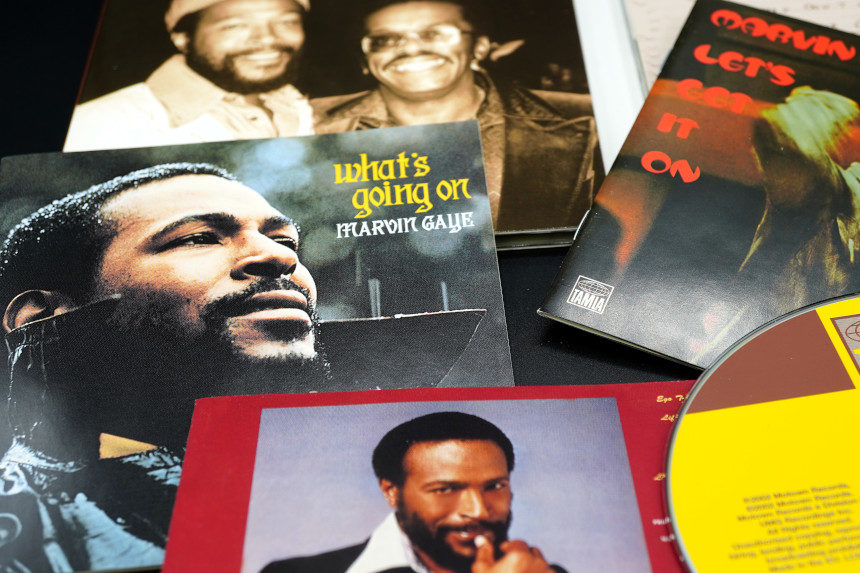Ambitious. Groundbreaking. Revolutionary. Masterpiece. Superlatives get tossed around all the time when critics, fans, and fellow musicians describe certain albums, but few hold up to the scrutiny. Fewer still build on their reputation over time. And an even smaller number manage to be both of-the-moment and prescient, constructed on such a wide scope of societal awareness that nine pieces of music remain sharp and relevant commentary five decades after they were first pressed to wax. But that’s what Marvin Gaye’s eleventh studio album, What’s Going On? managed to do.
Born in D.C. in 1939, Marvin Gay, Jr. (he would add the “e” later) discovered his love of music in his minister father’s church. Unfortunately, his father was also extremely abusive. His mother, however, encouraged him to sing, and Gaye found several doo-wop groups to perform with during his high school years. He eventually dropped out of school and joined the Air Force, but it was a poor fit and he obtained a General Discharge.
Gaye joined doo-wop group The Marquees and worked with talents like Bo Diddley and Chuck Berry. By December of 1960, he wound up at Berry Gordy’s house. Gaye sang for the Motown founder, who signed him to the Motown subsidiary label Tamla. He originally aspired to have a more jazz-oriented sound. While working on his own material, he also played drums as a session musician for the likes of The Marvelettes and The Miracles. That Marvelettes connection brought some good luck to both parties; Gaye both co-wrote and drummed on their 1962 hit, “Beechwood 4-5789.”
“I Heard It Through the Grapevine” (Uploaded to YouTube by Marvin Gaye)
Over the next few years, Gaye built momentum and fame with a series of solos and duets. His solo hits through 1967 included “Can I Get a Witness,” “How Sweet It Is (To Be Loved by You),” “I’ll Be Doggone,” and “Ain’t That Peculiar.” Among his classic duets with label-mate Tammi Terrell were “Your Precious Love,” “Ain’t Nothing Like the Real Thing,” “You’re All I Need to Get By,” and “Ain’t No Mountain High Enough.” In 1968, his version of “I Heard It Through the Grapevine” was a spectacular international success; number one in the U.S. and elsewhere, the tune sold millions of copies.
Unfortunately, Gaye’s success was offset by Terrell’s struggle with brain cancer. In fact, the cancer was first discovered after Gaye caught a collapsing Terrell during a show and she was taken to a local hospital. A series of operations followed; though Terrell kept recording, her stage career was basically over. She succumbed to the disease in March of 1970. Gaye had a crisis of conscience; depressed, disillusioned with the entertainment industry, and feeling like he wasn’t in charge of his own career, Gaye considered leaving music and trying out for the NFL’s Detroit Lions. The team passed over both liability concerns and the organization’s wish not to bring harm to Gaye’s performing career.
“What’s Going On?” (Uploaded to YouTube by Marvin Gaye)
Gaye ultimately returned to the studio at Motown and recorded the single, “What’s Going On?” on June 1, 1970. Gaye and Motown founder Berry Gordy clashed over the track. Whereas Gaye was trying to bring thoughtfulness and social consciousness to his music, Gordy feared that such a political song would jeopardize the headway that Gaye had made in expanding his audience. In response, Gaye went on strike, declining to release anything else until the company had the single in stores. When the single dropped in January of 1971, Gordy’s fears proved unfounded. The song was warmly received by critics and audiences; it lasted five weeks at the top of the R&B charts, went #1 on the Cashbox pop chart, and #2 on the Billboard Hot 100, ultimately selling two million copies.
The success surprised Gordy, and he and Gaye worked out something new for Motown: creative control. Typically, Motown and Tamla records had worked under a more factory-like process, with teams of songwriters crafting hits and house musicians like the Funk Brothers laying down the music. For the first time, Gaye would be in charge. However, Gordy wanted the album to be done quickly. Gaye responded by knocking out the majority of What’s Going On? in ten days. In addition to being the primary writer and sole producer, Gaye became the first Motown artist to specifically credit the Funk Brothers on his album.
“Mercy Mercy Me (The Ecology)” (Uploaded to YouTube by Marvin Gaye)
Released on May 21, 1971, What’s Going On? was a landmark. Both a concept album (the rough storyline followed a Vietnam veteran returning home, changed by the war and witness to other changes at home) and a general rumination on social movements that affected Gaye’s outlook, the album was an instant hit. The next two singles dealt with damage to the planet (Mercy Mercy Me (The Ecology)) and his own experience as a young Black man in a rough environment (Inner City Blues (Make Me Wanna Holler). Mercy went #1 R&B and #4 Pop while Blues went #1 R&B and #9 Pop. All three singles sold in excess of a million copies; the album itself went to #6 and sold two million copies in its first year.
Though obviously well-received and successful, the album’s reputation has only grown over time. Gaye’s assured writing and production, coupled with his incredibly soulful vocals, make the record a genuine statement in support of artists having creative control. Its overall message of self-examination and trying to come to grips with a flawed and frequently dangerous world continues to resonate. At the time, Time called the album a “vast, melodically deft symphonic pop suite.” What’s Going On? quickly entered the discussion when it came to the greatest albums of the rock era.
“Let’s Get It On” (Uploaded to YouTube by Marvin Gaye)
Gaye went right from What’s Going On? to two more classic albums: The Trouble Man soundtrack in 1972 and Let’s Get It On in 1973. Although Gaye continued to have successes, like a duet album with Diana Ross and some lucrative tours, the latter half of the 1970s saw him struggle with drugs and tax problems. His relationship with Motown soured, and he decamped to Europe for a while. By 1982, Gaye had moved past the drug issues and worked out a new deal with CBS Records’ Columbia label.
The resulting album Midnight Love proved to be a major comeback. The single “Sexual Healing” was a massive hit, topping charts and selling millions. Likewise, the album moved three million copies in the States. Gaye won two Grammys, his first, for the single. Unfortunately, while touring, Gaye’s drug problems recurred. He moved back with his parents in 1983.
On April 1, 1984, Gaye tried to stop a fight between his parents. It escalated into a physical fight with his father. Gaye’s father shot him twice, killing the singer. He was 44. In the wake of Gaye’s death, many of his albums re-entered the charts, including What’s Going On? Gaye would be posthumously inducted into the Rock and Roll Hall of Fame in 1987.
“Nightshift” (Uploaded to YouTube by The Commodores)
Gaye’s standing in the annals of music has only grown with each passing year. The 1985 hit “Nightshift” by The Commodores was about the loss of Gaye and fellow singer Jackie Wilson. A number of his songs have been used in films, commercials, and video games. The Trouble Man album has become a recurring reference in the Marvel Cinematic Universe, mentioned in both the film Captain America: The Winter Soldier and The Falcon and the Winter Soldier streaming series. Gaye’s estate has successfully sued to prevent unauthorized samples and other uses of his material.
As for What’s Going On?, the album has occupied a high place on the Rolling Stone magazine’s list of the 500 Greatest Albums of All Time for many years. Every time that the list was updated, it moved up. When the 2020 list was released, What’s Going On? had moved up to #1. The album was also considered the Best Album of All Time by writers of the British magazine NME in 1985. It was added to the National Recording Registry by the Library of Congress in 2003.
In the end, what makes What’s Going On? so great? It’s an intersection of terrific writing, production, musicianship, and vocal performance. It touches people at their core by dealing with real issues. It’s of its time, and yet it is strikingly relevant today in terms of its unflinching examination of poverty, race, the environment, and more. The album makes a real connection with the listener, and that emotional response is the aim of true art. Perhaps the only downside is that when Marvin Gaye’s voice reaches across the decades to ask us, “What’s going on?” we have to reply, “A lot of the same things.”
Featured image: Kraft74 / Shutterstock
Become a Saturday Evening Post member and enjoy unlimited access. Subscribe now




Comments
Marvin certainly spanned the years that mattered in music. I can believe he was making a name for himself while still in high school with doo-wop. Music was obviously something he was much more suited for than the Air Force, or the NFL. Working with Chuck Berry and Bo Diddley even before meeting Berry Gordy was very impressive, leading to substantial Motown connections.
Thanks for the link of Beechwood 4-5789 by the Marvelettes. A real classic, and the 2nd song of theirs Karen Carpenter did a wonderful version of too. I’m sorry he lost his partner Terri to brain cancer in 1970. I can see how he would have really been thrown for a loop.
I love “What’s Going On?” too, and this video. Too bad about the friction he had with Berry Gordy on it whose fears proved to be unfounded. I’m sorry he ran into difficulties later in the ’70s, having to sever ties with Motown. I’m glad he had another big hit in the early ’80s with ‘Sexual Healing’ before his tragic, shocking death. “What’s Going On?” indeed. A lot of the same things, as you state. One of the worst is homelessness, depicted at 3:07.